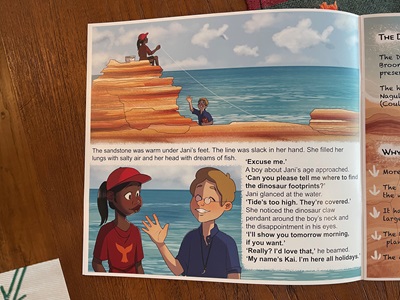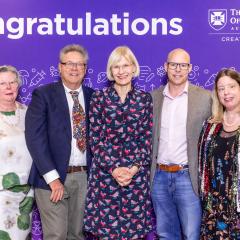
A new book for children, featuring Broome’s famous dinosaur tracks, has been launched with the help of The University of Queensland’s Dinosaur Lab.
Tracking Dinosaurs is a story about two children who meet and together explore the Broome coast for dinosaur tracks, written by Deb Hannagan and illustrated by Jade de Baecque.
UQ’s Associate Professor Steven Salisbury provided his palaeontological expertise to help tell the story of the coast’s 130-million-year-old footprints.
“The rocks around Broome preserve the most diverse set of dinosaur tracks in the world,” Dr Salisbury said.
“The tracks are preserved in the rock unit known as the Broome Sandstone, scattered over 80 kilometres of National Heritage listed coastline from Roebuck Bay all the way up past Walmadany (James Price Point) on the Dampier Peninsula.
“It’s an amazing record of the past, with over 20 different types of tracks: there are five different types of predatory dinosaur tracks, at least six types of tracks from long-necked herbivorous sauropods, four types of tracks from two-legged herbivorous ornithopods, and six types of tracks from armoured dinosaurs.
“Significantly, these tracks are also woven into the Indigenous culture of the area, and forms part of a Song Cycle that travels along the coastline.

“So, I’m extremely excited for today’s kids to read this book and to get excited about dinosaurs in a new light.
“I’m pretty sure this is the first time a children’s dinosaur book has featured such a beautiful blend of Indigenous and western views of palaeontology – it’s how it should be.”
Dr Salisbury said the story in Tracking Dinosaurs was very personal for him.
“When I first arrived in the Kimberley fifteen years ago, I was a bit like Kai, the dinosaur-obsessed boy in the story,” he said.
“I thought I knew everything there was to know about dinosaurs, but I soon realised that wasn’t the case, and that palaeontology has been happening here for a very long time.
“It’s great to get that message out to the next generation of dinosaur enthusiasts.”
The collaboration had input from Dr Salisbury, writer Deb Hannagan, illustrator Jade de Baecque, the Dinosaur Coast Management Group and critically, Traditional Custodians and Knowledge Holders.
“The story this book conveys is a wonderful example of how Western and Indigenous knowledge systems can come together to provide a deeper, more wholistic understanding of the natural world,” Dr Salisbury said.

Djukun Elder Mary Ozies and Djukun representative Stanley Ozies expressed gratitude to the creators of the book.
“Thank you to Debra Hannagan and Jade de Baecque for collaborating with Traditional Owners, palaeontologist Steve Salisbury, and the Dinosaur Coast Management Group to bring this amazing book to life,” Ms Ozies said.
“It’s wonderful to see our Djukun Dreamtime stories brought to life in this beautiful book,” Mr Ozies said.
Daniel Roe, General Manager of Goolarabooloo Millibinjarri Indigenous Corporation, wholeheartedly agreed.
“It was a privilege to have provided the cultural guidance and advice for this book, which also reflects on an Indigenous cultural connection to the dinosaur tracks through Marala, the Emu Man, who is an important Creator Being for this part of the West Kimberley,” he said.
Tracking Dinosaurs was supported by a community engagement grant from Lotterywest to The Dinosaur Coast Management Group.
Media: A/Prof Steve Salisbury, s.salisbury@uq.edu.au, +61 407 788 660; Faculty of Science Media, science.media@uq.edu.au, +61 438 162 687.



